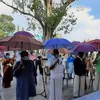Inclusive, intuitive, integrated – DesignUp panelists share design principles for the coronavirus era
In our second preview article on the upcoming DesignUp panel, experts share insights from the travel, photography, and design sectors.
The team behind the DesignUp conferences is hosting a panel this coming Sunday, May 24, 5-6 pm, titled ‘The Travel 5x5: End of Wanderlust?’ YourStory is the media partner for the event (click here for free registration).

In this second preview article, five panelists set the stage on design principles in the COVID-19 era, effective remote work, and engaging online interactions. See Part I of our preview article here.
In an original format, five speakers – from five cities and five different industries – will deliver fast-paced presentations of five slides each on virtual travel, changing preferences, and choice of destination. The panelists are from Bengaluru, Delhi, Bangkok, Sydney, and Singapore.
See YourStory’s coverage of the annual DesignUp conference editions from 2019, 2018, and 2017, as well as our d-Zen (‘Design Zen’) section, for more design resources. Also check out our coverage of DesignUp’s earlier online panels, The (not so) Secret Life of Designers, May the Fourth be with you, and The pandemic’s impact on design as a business.
The speaker lineup this time includes Dorothy Di Stefano, Founder-Director, Molten Immersive Art; Srishti Gupta, Manager, Product Design, MakeMyTrip; Jayanth Sharma, CEO, Toehold Travel and Photography; Deven Grover, Senior Product Design Manager, Agoda; and Sebastian Mueller, Co-Founder, MING Labs.
Design principles for the changed reality
Given that we may have to live with the coronavirus for the foreseeable future rather than being able to vanquish it, new mindsets of resilience and creativity are called for. The speakers highlighted a range of principles for designers to keep in mind in this ‘new normal’.
“We will be designing for remote and isolated use of products and interfaces,” Srishti explains. Additionally, these users will come from every walk of life, such as the elderly and less tech-savvy people.
“As designers, it should be our aim to reduce cognitive load by improving information and interface design. Form should follow function,” she adds. She also cites Jakob’s Law of UX: By leveraging existing mental models, we can create superior user experiences in which the user can focus on their task, rather than learning new models.
“Go back to the basics when in doubt. Always refer to Jakob Nielsen's 10 general principles of usability,” Srishti urges.
“People are becoming more socially aware, so we will start to see more design and art centred on the themes of social action and engagement,” Dorothy explains. As we globally experience climate change and are more aware of this reality, designers should continue to explore environmental themes, she adds.
“Designers are both using technology to produce design/art, and are also creating work about the role of technology in our lives. Designers should embrace multi-futurism to process our present and speculate about the world we live in and our many possible future pathways,” Dorothy emphasises.
Sebastian lists three key principles for designers: trust, control, and emotions. “Reassure users as much as possible. Address users need to feel in control of their experience. Predict and guide the emotional journey as appropriate,” he explains.

“Focus on what matters versus the routine. During COVID-19, as organisations look to be more cost-effective, they should also work on impactful projects,” Deven advises. “Cut the fat out to ensure your team is driving value, and have a laser focus on initiatives that align with business needs and user needs to get through the crisis, he adds.
Companies should go beyond immediate problem-solving, and also contribute to and serve the larger public. “Try to find ways to educate and help the team get through the crisis,” Deven says.
“There is an acute need for standardised, consistent, and effective information design, that will lower anxiety and drive people to reliable resources. Consistent content will help lower confusion or trust issues with your consumers,” he advises.
“Be transparent in messaging to build user trust. If you get them on your side through the crises, they will always remember you for it, and be loyal in the future,” Deven emphasises.
Reflection and reinvention
Professional photographers are coping with and responding to this new reality in novel ways. “Most of them are working on their archives of images over the years, which didn’t get much attention as life was so busy. But now, they are relooking at images from assignments and shoots that didn’t get noticed in their fast-paced life,” Jayanth observes.
Many of them are multiplying their reach actively on social media as well. They are conducting Facebook and Instagram live sessions, and chatting with others to share knowledge and experiences with hobby photographers.
“People like me have started evolving in the digital space. We now conduct virtual photography classes, which otherwise could happen in banquet halls and classrooms,” Jayanth explains.
He personally feels that the difference between online and in-person training isn’t really much. “In fact, I can’t think of why we would do workshops in person with high costs anymore,” he observes.
Remote work
For those who are privileged enough to still have a job, and have the good fortune of being able to work from home, this model of work ushers in a new paradigm of collaborative work. But this forced transformation has thrown up some challenges, and some corrective responses as well.
“Workshops are more challenging in remote mode,” Sebastian cautions. He has compiled an online list of useful solutions in this regard (see How to run great remote workshops). Staying connected with the team is harder during WFH (see his list of Seven Ideas for Teams to Stay Connected Remotely).
“Drawing the boundaries between work and personal time becomes really hard, and days become much longer. Have the discipline to draw lines between them,” Sebastian emphasises.
“Conducting a video meeting in the spare bedroom never looks or feels professional. I've taken time to create an office space that is visible from the camera's point of view,” Dorothy explains.
She also recommends purchasing a USB microphone for smartphone and computer video recordings and discussions to improve the quality of remote communications and productions. “Feeling isolated is probably something we can all relate to. Catching up with my team online first thing in the morning has been extremely beneficial,” Dorothy adds.
Due to international travel restrictions, her team is making new connections with suppliers in various countries to complete site-specific projects. “Extensive research, and of course, sound recommendations assist in this process,” she says.
Time management, work-life balance, and dress code are issues flagged off by Deven. “To effectively manage your own schedule and time, it is important to ensure your work-life balance still stays intact,” he advises. He recommends setting alarms on the phone as reminders for stretch breaks, spending evening time with family and friends, and avoiding checking emails after work hours.
“Stick to a schedule and follow it as if you are working from the office. Working from home often makes you feel as if you have never logged off work, and it just a long day with no balance between personal and professional life,” Deven cautions.
He advises the separation of space between the home office and the area of relaxation. “Take time off during the day as if you were in the office by eating lunch away from your home-office desk, or doing a workout in other rooms,” he adds. This brings some changes to a day of just sitting at the desk.
Deven also warns of the “work in your PJ's trap.” Though video callers only see shoulders and above on camera, it is important to feel there is a routine that includes proper clothes. “A focus on having a schedule in the morning for hygiene, showering, and feeling clean will improve your professionalism and performance,” he advises.
“The line between work and home has been blurred. It has become easier for someone to burn out by not respecting the importance of a work-life balance,” Srishti cautions.
Still, when leveraged effectively, WFH has been a boon in terms of productivity for designers. “Except for the initial growing pains of coordinating as a team remotely, I think this is enabling teams to have clearer communication and accountability as well. This working style also benefits employers and the planet in general,” she adds.
“I have a peculiar challenge, I have been working 15-16 hours a day because I am working from my study,” Jayanth observes. “So unless I deliberately defocus from work, I am constantly doing something productive. So sometimes I need to consciously remind myself to watch something else entertaining and take a break from work,” he explains.
This ease of slipping into overwork is a concern expressed by many in the creative fields. Still, it is amazing to have this WFH option when others are not so fortunate, Jayanth acknowledges. “Going to work is just a few feet away,” he jokes.
He is also improving his skills in better online communication to delegate work to colleagues. “I find it a bit tough to get things done from colleagues as easily as I could when we were in the office. So while instructions have to be heard patiently, it has to be given in such a way that there’s no ambiguity or doubt,” he adds.
Organising and learning from online events
In an earlier interview, MakeMyTrip founder Deep Kalra describes how people may travel in a post-COVID-19 world. The CII (Confederation of Indian Industry) estimates a loss of a Rs 5 lakh crore to the travel and tourism sector, which may result in five crore jobs being lost.
Recovery by phase will be in the following sequence: essential travel, business travel, and leisure travel (first domestic and then international). Group travel and mega-events will take a bad hit, according to Deep.
The design and travel communities are coming together to find ways out of the crisis, and effective online forums are crucial platforms in this regard. But in a world of unending and crowded screen time, it is important to stand out from the crowd and be effective as well.
“Understanding your audience is really the key to finding something that meets their expectations. What works in offline simply doesn't work online – and given the fatigue, it is important to think shorter, crisper,” Jay advises online event organisers.
“Experiment, experiment, experiment. Try out different speakers, long and short talks, panels, Q&A, show and tell,” he adds. In an era of never-ending webinars and video-conferencing calls, productivity hacks are also called for.
“I love taking brief notes interspersed with plenty of doodles. That keeps the focus on,” Jay recommends. “You don't need to be an artist, but when you're not creating copious notes, you're focusing on the words being said,” he observes.
“I find sketching to be very ‘focusing’ and a way to deal with the overload. But again, each of us has a different way of learning and reflecting - words, images in your mind, writing it down, speaking along, doing sketchnotes. Find your way of learning by experimenting,” Jay signs off.
Edited by Suman Singh










